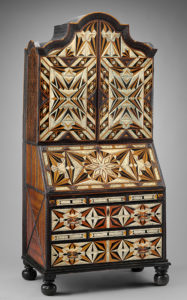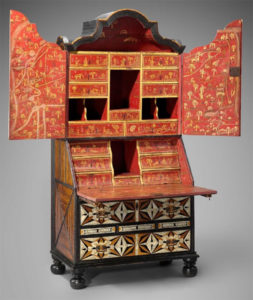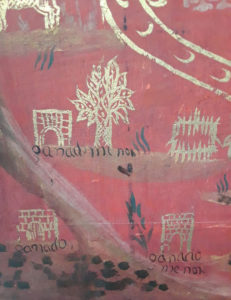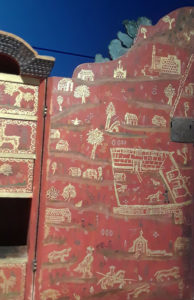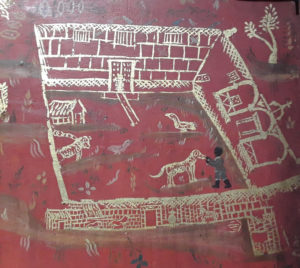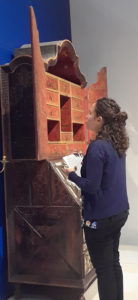The Folded Spaces of Two Pueblan Colonial Desks
EMERGING SCHOLARS > SUMMER RESEARCH GRANTS
by Celia Rodríguez Tejuca
This summer, I embarked on a trip to Puebla, Mexico, to complete my research on a pair of 18th-century desks and bookcases that reinforce the aesthetic connections between East Asia and the Spanish-American viceroyalties during the colonial period. Given their visual similarities, the two mid-18th-century desks were presumably displayed together but now reside in different collections: one at the Museum of Fine Arts (MFA), Boston (figures 1 and 2); the other at the Museum José Luis Bello y González in Puebla, Mexico (figures 3, 4, 5, and 6). Having previously studied the MFA desk in detail, I needed to examine its counterpart in Mexico. My objective was to imagine how the pieces worked together as they opened and revealed their interiors.
Once the doors of the bookcases are open, bright red and golden surfaces dramatically appear. The interiors of the doors show indigenous cartographic views of the properties that belonged to the Rivadeneira family, the presumed owners of the desks. Their disjointed spatial depictions are integrated through a strident Japanesque chromatic style. Such East Asian aesthetics also resonate within the physical disposition of the maps. Distributed as fragmented and movable sections, the cartographic views set in motion physical, rational, and sensual interactions with the space, like the viewing system of Spanish-American viceregal folding screens, a local adaptation of the Japanese luxury goods known as biombos.
I had the opportunity to examine maps of Rivadeneira land holdings in the General Archive of the Nation in Mexico City. Indigenous tlacuilos designed these documents for the legal attribution and distribution of land. When contrasting them with the cartographic views displayed in the desks’ panels, however, it is not possible to identify instances of direct copying, even if specific pictograms repeat. Perhaps other maps more accurately mirrored the images depicted on the desks, but were discarded in response to changing land ownership. A 2003 study revealed that the borders of the Rivadeneira properties remained imprecise and contested.
In Puebla, I met with Dr. Patricia Domínguez, Director of the Museum José Luis Bello y González, who provided access to the limited archival records tied to the object. The desk is on loan to the acclaimed International Museum of the Baroque in Puebla, where it is exhibited with the doors closed. Once I completed the required paperwork, the doors of the bookcase were finally opened. The reaction of the museum staff was revealing. In a few minutes, the room was full of guards taking photos of the unusual event. This was their first opportunity to see the bright red and gilt interior of the bookcase, and they were astonished by such an extraordinary revelation.
During the visit, I was able to corroborate my thesis of how the theatricality of these desks created a diachronic and synchronic narrative of land ownership. After close examination of the desk in Puebla, I also discovered substantial differences in the iconographic and textual systems of the two objects. While the example in Boston is full of inscriptions, the desk in Puebla only has one door with text (figure 3).
Before my visit to Puebla, I had interpreted the textual inscriptions on the cartographic views as a history of geography in the 16th and 18th centuries. For example, within the maps decorating the desk at the MFA, multiple mentions of Gaspar de Rivadeneira are noticeable. Gaspar started the lineage of the Rivadeneiras in colonial Mexico in the 16th century. His presence on this piece of furniture is especially relevant to the desk’s rhetorical function as the “ancestor” who created the estate. The frequent references to cattle farming in image and text contrasts the land between a natural state and a territory undergoing intensive economic exploitation that reinforces the Rivadeneiras’ right to ownership. The space is framed within a continuous history.
The lack of text in the panel in Puebla, as well as the change in scale of the depiction of the hacienda, implies an evolution in time and space (figures 4 and 5). Additionally, the depiction of African-American figures in this door links the land with the family’s initiative to support populations of freed slaves in the 18th century. Therefore, their appearance in the desk’s iconographic program establishes the recent history of the Rivadeneira’s hacienda.
To create a comprehensive understanding of the territory pictured, the viewer had to open the two sets of doors and visually piece the spaces together. This practice of fragmentary reading was matched by the colonial consumption of biombos. The pair of desks produced specific dialogue through a transoceanic context and a rhetorical performance as vehicles of knowledge, identity, and aesthetic pleasure.
I greatly appreciate receiving a Decorative Arts Trust Summer Research Grant to travel to Puebla, Mexico, to study this remarkable desk and bookcase in support of my thesis.
Celia Rodríguez Tejuca studies Art History at Johns Hopkins University and was a 2019 Summer Research Grant recipient.
A print version of this article was published in The Magazine of the Decorative Arts Trust, one of our most popular member benefits. Join today!

